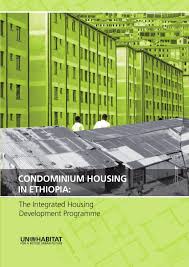Condominium Housing in Ethiopia: The Integrated Housing Development Programme

This report forms part of the UN-Habitat series “Housing Practices: country experiences of designing and implementing affordable housing programmes”. Condominium Housing in Ethiopia describes the ambitious goals and efforts set out by the Ethiopian state since 2005 to construct housing for low- and middle-income people, to create a significant number of jobs and to promote small enterprises.
The document gives a detailed account of the design and implementation of the Integrated Housing Development Programme (IHDP). It also reflects on the country’s experiences and challenges that are common to large-scale housing programmes, as well as those related to the particular Ethiopian context. The report thus aims to provide policymakers, urban practitioners and public officials with valuable insights on how Ethiopia – a country with high levels of unemployment, high population growth, severe inadequacies in the provision of basic infrastructure and services, a housing deficit of an estimated 1 million units, and 70 per cent of its existing housing stock in need of total replacement – can provide affordable housing and secure low-income dwellers access to financing mechanisms.
The latter is particularly relevant considering the shift from a government monopoly on building and construction material – which currently accounts for about 70 per cent of the total construction costs – in the early 1990s towards a market-based approach, which excludes large sections of the urban population from the possibility to live in a decent house. The IHDP clearly emphasizes housing as an instrument to foster urban development. The focus is not only on increasing the housing stock and providing access to homeownership, but also on creating job opportunities and revitalizing the economy, improving people’s overall quality of life, and recognizing existing informal settlements while preventing their expansion.
The report’s descriptions of the institutional design and finance mechanisms, underlying urbanization and densification policies, and operational steps of the programme and its lottery system are further described in boxes, which give interested readers a detailed account of particular aspects of the IHDP. The authors highlight several times that the initial IHDP targets were highly ambitious: reducing informal settlement areas by 50 per cent and building nearly 400,000 housing units in five years. These goals have not been reached as of mid-2010, with 80,257 units built in about 100 project sites, varying in size from 300 to over 10,000 units. (See Chapter 3 on programme performance, anticipated and unanticipated results, achievements and challenges.)
Chapter 4 extracts the key lessons that can be learnt after five years of experience. It highlights amongst other lessons the importance of strong political commitment, tenure security, capacity building, housing quality and an increased focus on the protection of human rights during resettlement processes.
Available from: http://www.iut.nu/Facts%20and%20figures/Africa/Ethiopia_CondominiumHousingUN-Habitat2011.pdf
Book note prepared by Julia Wesely
Search the Book notes database
Our Book notes database contains details and summaries of all the publications included in Book notes since 1993 - with details on how to obtain/download.
Use the search form above, or visit the Book notes landing page for more options and latest content.
For a searchable database for papers in Environment and Urbanization, go to http://eau.sagepub.com/

